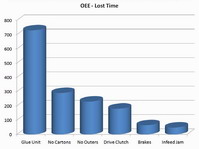 Talking to Joel Leonard, the
But unfortunately these systems are often used by Operation and Production departments as the means to report the extent of ‘engineering failure’, with ‘engineering breakdown’ records used to excuse missed production targets.
Talking to Joel Leonard, the
But unfortunately these systems are often used by Operation and Production departments as the means to report the extent of ‘engineering failure’, with ‘engineering breakdown’ records used to excuse missed production targets. This limited view usually results in ‘engineering’ being blamed for most output failures, but worse, it results in a great deal of lost economic opportunity because no one is keeping score of the other performance issues which effect Overall Equipment Effectiveness (OEE).
At the other extreme, OEE Systems are regarded as a production tool, often ignored by engineering and as a result, restricting the value of some engineering KPI’s. Whilst engineers may work hard to complete maintenance against plan, can we be really sure the plan is sound and is the most effective way to eliminate losses and improve plant performance?
There is little point in praising the engineering department for completing 490 out of 500 work orders on time unless we can be sure those 500 tasks were necessary and effective. The key issue for maintenance engineers must be to identify and complete the most appropriate maintenance.
To quote Peter Drucker, management guru: “Efficiency is doing things right; effectiveness is doing the right things.” Knowing exactly how well the plant is performing will help to drive engineering to do ‘the right things’. It seems obvious then that we must direct maintenance to critical areas identified by OEE and loss management.
So why not bring the maintenance and production functions more closely together? Why not use the data from OEE analysis to generate maintenance requirements? An effective OEE System will also measure failures, reporting on when, how, and for how long, as well as providing MTBF and MTTR.
Companies who recognise the value of OEE usually begin with a spreadsheet for each production line; however a spreadsheet simply doesn’t have the power most complex plants needs for OEE analysis, and cannot normally provide the maintenance pointers engineers need. Companies very quickly ‘outgrow’ this spreadsheet approach. OEE management should also consist of more than a series of graphs in production department corridors. A dedicated OEE System, including software, business processes and a supportive shop-floor culture, should provide direction for the maintenance strategy and the key tool for loss management.
Let’s consider the glue unit as an example:
The metric shows that the glue unit availability is running at a loss of over 700 minutes in a single week. Drill down analysis highlights supply as the root cause of the issue.
{mosimage}Using an OEE System to analyse the unit, drilling down through OEE availability metrics reveals that glue issues are resulting in the worst loss - over 700 minutes in a single week. An immediate temptation is perhaps to have the engineers strip the unit during a quiet evening period, clean, replace some worn parts and hope for a better run tomorrow. However, further analysis shows that the result of not having cartons or outers, has lost a total of 500 minutes. Perhaps the FLT driver is just not getting the right items in the right place at the right time; surely this is an easier problem to resolve than an unspecified, potentially complex engineering issue. Furthermore, ‘what if’ OEE analysis shows that several machines of a similar type are having the same problems, a ‘5 why’s’ test is completed and the results show that the root cause of lost time for the week is glue supply. Appropriate counter-measures such as auditing the glue supplier, checking incoming batches etc. will prove more effective. Stripping the glue unit could well have made the matter worse. Completing the wrong/unnecessary maintenance, even if done quickly and to the highest standard, won’t enable the plant to run to speed.
‘5 whys’ is a proven technique to discover the root cause of failures. The glue failure was a symptom; analysis reveals that the real issue was late deliveries from the supplier.
Maintenance decisions, then, need to be made using accurate and complete performance data. But often companies spend too much time gathering data, leaving little time to re-act to that data. OEE tools need a powerful improvement agenda so that as incidents are identified, targets, reviews and completion dates can be set. These tasks should be highly visible, provide clear accountability and clarify improvement responsibilities.
At all times, every department should be able to answer three questions:
- When was the last time a 1 hour breakdown occurred?
- When was the time before that?
- What about the time before that?
And then three more:
- What maintenance counter-measures have been put in place to eliminate the issue?
- Is the maintenance plan working?
- Does the whole team understand what was lost, and the financial prize to be gained?
And the answers should be the same. Constantly measuring OEE and aligning maintenance plans according to the results will ensure that the most effective maintenance is planned and the most accurate picture of performance is painted.
One final point; if you believe your CMMS alone can improve your plant’s performance, I’m afraid you are missing the bigger picture. On the other hand, don’t underestimate the fact that good maintenance systems and a clear strategy are essential to help resolve the issues OEE systems identify. Integrated OEE and Maintenance systems form an effective combination – and above all else, we must be effective.
Alan France is Operations Director of Idhammar Systems Limited.
He can be contacted by e-mail on This email address is being protected from spambots. You need JavaScript enabled to view it. or see www.idhammarsystems.com for more on OEE software.

